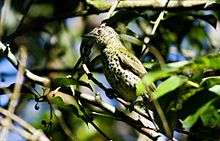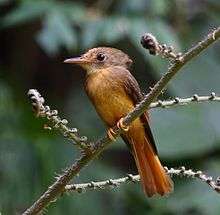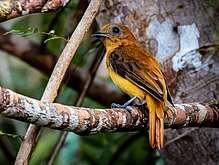Tityridae
Tityridae is family of suboscine passerine birds found in forest and woodland in the Neotropics. The 45 species in this family were formerly spread over the families Tyrannidae, Pipridae and Cotingidae (see Taxonomy). As yet, no widely accepted common name exists for the family, although tityras and allies and tityras, mourners and allies have been used. They are small to medium-sized birds. Under current classification, the family ranges in size from the buff-throated purpletuft, at 9.5 cm (3.7 in) and 10 grams (0.35 ounces), to the masked tityra, at up to 24 cm (9.5 in) and 88 grams (3.1 ounces).[2][3] Most have relatively short tails and large heads.
| Tityridae | |
|---|---|
 | |
| Chestnut-crowned becard | |
| Scientific classification | |
| Kingdom: | Animalia |
| Phylum: | Chordata |
| Class: | Aves |
| Order: | Passeriformes |
| Parvorder: | Tyrannida |
| Family: | Tityridae Gray, GR, 1840 |
| Genera | |
|
see text | |
| Tityridae phylogeny | |||||||||||||||||||||||||||||||||||||||||||||||||||||||||
| |||||||||||||||||||||||||||||||||||||||||||||||||||||||||
| Cladogram of the genera in Tityridae based on the results of Ohlson and colleagues published in 2013. Xenopsaris was not included in the analysis.[1] |
Taxonomy and systematics
The family Tityridae (as the subfamily Tityrinae) containing the genera Tityra and Pachyramphus was introduced by the English zoologist George Robert Gray in 1840.[4][5]
Traditionally, the genus Laniocera was included in the family Tyrannidae, the genera Iodopleura, Laniisoma, Tityra, Pachyramphus and Xenopsaris were included in the family Cotingidae, and Schiffornis was included in the family Pipridae. Three of these genera, Tityra, Pachyramphus and Xenopsaris, were later moved to Tyrannidae based on the morphology of their skull and syrinx.[6]
The existence of the family Tityridae (although simply treated as a clade) was first proposed in 1989 based on the morphology of several syringeal and skeletal features.[7] The existence of this family has later been confirmed by multiple studies involving both mitochondrial DNA and nuclear DNA.[8][9][10][11][12] Evidence suggests there are two basal clades within this family, the first including the genera Schiffornis, Laniocera, and Laniisoma (with strong bootstrap support), and the second include Iodopleura, Tityra, Xenopsaris, and Pachyramphus (with poor bootstrap support).[13]
A molecular phylogenetic study of passerine families published in 2019 sampled species from five genera in Tityridae. The resulting tree indicates that if the family Tityridae is defined to include the genera Oxyruncus, Myiobius and Onychorhynchus then it becomes paraphyletic: a clade containing the genera Tityra and Schiffornis is basal to a clade that contains the genera Oxyruncus, Myiobius, Onychorhynchus and the family Tyrannidae.[14]
Species
The family contains 45 species divided into 11 genera:[15]
| Image | Genus | Living Species |
|---|---|---|
 | Oxyruncus Temminck, 1820 |
|
 | Onychorhynchus Fischer von Waldheim, 1810 |
|
| Myiobius Gray, GR, 1839 |
| |
.jpg) | Terenotriccus Ridgway, 1905 |
|
 | Tityra Vieillot, 1816 |
|
 | Schiffornis Bonaparte, 1854 |
|
| Laniocera Lesson, 1841 |
| |
.jpg) | Iodopleura Lesson, 1839 |
|
.jpg) | Laniisoma Swainson, 1832 |
|
.jpg) | Xenopsaris Ridgway, 1891 |
|
 | Pachyramphus Gould & G.R. Gray, 1839 |
|
References
- Ohlson, J.I.; Irestedt, M.; Ericson, P.G.P.; Fjeldså, J. (2013). "Phylogeny and classification of the New World suboscines (Aves, Passeriformes)" (PDF). Zootaxa. 3613 (1): 1–35. doi:10.11646/zootaxa.3613.1.1.
- Snow, D.; Sharpe, C.J. (2018). del Hoyo, J.; Elliott, A.; Sargatal, J.; Christie, D.A.; de Juana, E. (eds.). "Buff-throated Purpletuft (Iodopleura pipra)". Handbook of the Birds of the World Alive. Lynx Edicions. Retrieved 10 January 2018.
- Mobley, J.; de Juana, E. (2018). del Hoyo, J.; Elliott, A.; Sargatal, J.; Christie, D.A.; de Juana, E. (eds.). "Masked Tityra (Tityra semifasciata)". Handbook of the Birds of the World Alive. Lynx Edicions. Retrieved 10 January 2018.
- Gray, George Robert (1840). A List of the Genera of Birds : with an indication of the typical species of each genus. London: R. and J.E. Taylor. p. 31.
- Bock, Walter J. (1994). History and Nomenclature of Avian Family-Group Names. Bulletin of the American Museum of Natural History. Number 222. New York: American Museum of Natural History. pp. 149, 237.
- Ames, P.L. (1971). The Morphology of the Syrinx in Passerine Birds (PDF). Peabody Museum Bulletin. Volume 37. New Haven, Connecticut, USA: Peabody Museum of Natural History. pp. 95–97.
- Prum, R.O.; Lanyon, W.E. (1989). "Monophyly and phylogeny of the Schiffornis group (Tyrannoidea)" (PDF). Condor. 91: 444–461. doi:10.2307/1368323. JSTOR 1368323.
- Ericson, P.G.P.; Zuccon, D.; Johansson, U.S.; Alvarenga, H.; Prum, R.O. (2006). "Higher-level phylogeny and morphological evolution of tyrant flycatchers, cotingas, manakins, and their allies (Aves: Tyrannida)". Molecular Phylogenetics and Evolution. 40 (2): 471–483. doi:10.1016/j.ympev.2006.03.031.
- Ohlson, J.I.; Prum, R.O.; Ericson, P.G.P. (2007). "A molecular phylogeny of the cotingas (Aves: Cotingidae)". Molecular Phylogenetics and Evolution. 42 (1): 25–37. doi:10.1016/j.ympev.2006.05.041. PMID 16876441.
- Chesser, R.T. (2004). "Molecular systematics of New World suboscine birds". Molecular Phylogenetics and Evolution. 32 (1): 11–24. doi:10.1016/j.ympev.2003.11.015.
- Johansson, U.S.; Irestedt, M.; Parsons, T.J.; Ericson, P.G.P. (2002). "Basal phylogeny of the Tyrannoidea based on comparisons of cytochrome b and exons of nuclear c-myc and RAG-1 genes" (PDF). Auk. 119 (4): 984–995. doi:10.1642/0004-8038(2002)119[0984:BPOTTB]2.0.CO;2.
- Prum, R.O.; Rice, N.H.; Mobley, J.A.; Dimmick, W.W. (2000). "A preliminary phylogenetic hypothesis for the cotingas (Cotingidae) based on mitochondrial DNA" (PDF). Auk. 117 (1): 236–241. doi:10.1642/0004-8038(2000)117[0236:APPHFT]2.0.CO;2.
- Barber, B.R.; Rice, N.H. (2007). "Systematics and evolution in the Tityrinae (Passeriformes: Tyrannoidea)". Auk. 124 (4): 1317–1329. doi:10.1642/0004-8038(2007)124[1317:SAEITT]2.0.CO;2.
- Oliveros, C.H.; et al. (2019). "Earth history and the passerine superradiation". Proceedings of the National Academy of Sciences of the United States of America. 116 (16): 7916–7925. doi:10.1073/pnas.1813206116. PMC 6475423. PMID 30936315.
- Gill, Frank; Donsker, David, eds. (2017). "Cotingas, manakins, tityras & becards". World Bird List Version 7.3. International Ornithologists' Union. Retrieved 9 January 2018.
| Wikimedia Commons has media related to Tityridae. |